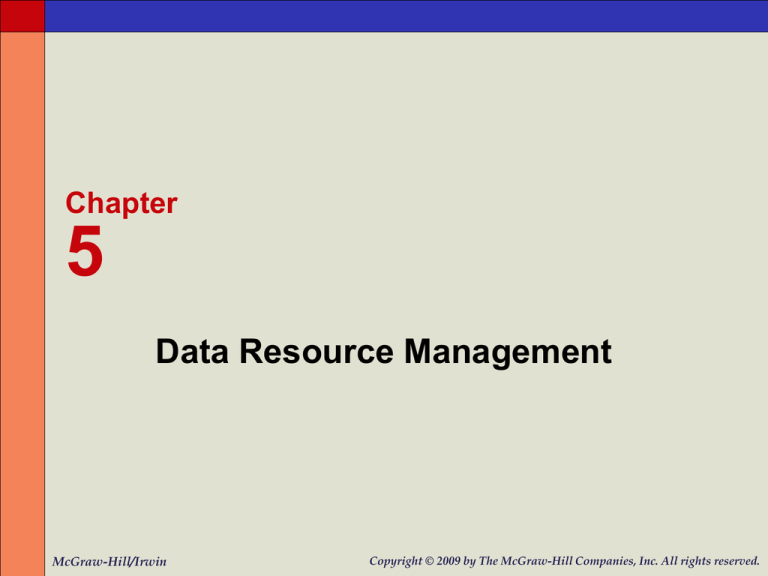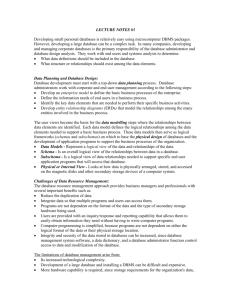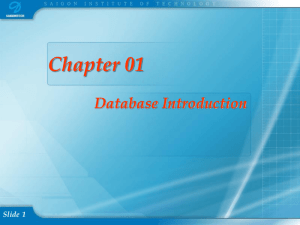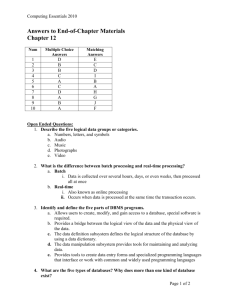
Chapter
5
Data Resource Management
McGraw-Hill/Irwin
Copyright © 2009 by The McGraw-Hill Companies, Inc. All rights reserved.
Learning Objectives
• Explain the business value of implementing
data resource management processes and
technologies in an organization
• Outline the advantages of a database
management approach to managing the data
resources of a business, compared to a file
processing approach
• Explain how database management software
helps business professionals and supports the
operations and management of a business
5-2
Learning Objectives
• Provide examples to illustrate the
following concepts
– Major types of databases
– Data warehouses and data mining
– Logical data elements
– Fundamental database structures
– Database development
5-3
Case 1: Cogent Communications, Intel,
and Others
• IT integration and adoption issues can make or break merger
and acquisition activities.
• Experts and IT managers agree that companies will feel the
full impact of the merger and acquisition frenzy directly in
their data centers.
• Companies that have data centers where the employees hold
all the knowledge suffer greatly when, after a merger or
acquisition, those people are let go.
• It is important to document the knowledge from those people
and figure out how to make the processes work with only a
handful of employees.
• Companies should have good information about what goes
on in the data center in terms of systems and how they
interact with each other and interface with the business.
5-4
Case Study Questions
1. Place yourself in the role of a manager at a
company undergoing a merge or acquisition. What
would be the most important things customers
would expect from you while still in that process?
What role would IT play in meeting those
expectations? Provide at least three examples.
2. Focus on what Andi Mann in the case calls “tribal
knowledge.” What do you think he means by that,
and why is it so important to this process? What
strategies would you suggest for companies that
are faced with the extensive presence of this issue
in an acquired organization? Develop some
specific recommendations.
5-5
Case Study Questions
3. Most of the discussion on the case
focused on hardware and software issues.
However, these are essentially enablers
for underlying business processes
developed by each of the companies
involved. What different alternatives do
companies have for merging their
business processes, and what role would
IT play in supporting those activities? Pay
particular attention to data management
and governance issues.
5-6
Logical Data Elements
5-7
Logical Data Elements
• Character
– A single alphabetic, numeric, or other symbol
• Field or data item
– Represents an attribute (characteristic or
quality)
of some entity (object, person, place, event)
• Examples: salary, job title
• Record
– Grouping of all the fields used to describe the
attributes of an entity
• Example: payroll record with name, SSN, pay rate
5-8
Logical Data Elements
• File or table
– A group of related records
• Database
– An integrated collection of logically
related
data elements
5-9
Electric Utility Database
5-10
Database Structures
• Common database structures…
– Hierarchical
– Network
– Relational
– Object-oriented
– Multi-dimensional
5-11
Hierarchical Structure
– Early DBMS structure
– Records arranged in tree-like structure
– Relationships are one-to-many
5-12
Network Structure
– Used in some mainframe DBMS
packages
– Many-to-many relationships
5-13
Relational Structure
• Most widely used structure
– Data elements are stored in tables
– Row represents a record; column is a field
– Can relate data in one file with data in another,
if both files share a common data element
5-14
Relational Operations
• Select
– Create a subset of records that meet a
stated criterion
• Example: employees earning more than $30,000
• Join
– Combine two or more tables temporarily
– Looks like one big table
• Project
– Create a subset of columns in a table
5-15
Multidimensional Structure
• Variation of relational model
– Uses multidimensional structures to
organize data
– Data elements are viewed as being in
cubes
– Popular for analytical databases that
support Online Analytical Processing
(OLAP)
5-16
Multidimensional Model
5-17
Object-Oriented Structure
• An object consists of
– Data values describing the attributes of an
entity
– Operations that can be performed on the data
• Encapsulation
– Combine data and operations
• Inheritance
– New objects can be created by replicating
some or all of the characteristics of parent
objects
5-18
Object-Oriented Structure
Source: Adapted from Ivar Jacobsen, Maria Ericsson, and Ageneta Jacobsen, The Object Advantage: Business Process
Reengineering with Object Technology (New York: ACM Press, 1995), p. 65.
Copyright @ 1995, Association for Computing Machinery. By permission.
5-19
Object-Oriented Structure
• Used in object-oriented database
management systems (OODBMS)
• Supports complex data types more
efficiently than relational databases
– Examples: graphic images, video
clips,
web pages
5-20
Evaluation of Database Structures
• Hierarchical
– Works for structured, routine transactions
– Can’t handle many-to-many relationship
• Network
– More flexible than hierarchical
– Unable to handle ad hoc requests
• Relational
– Easily responds to ad hoc requests
– Easier to work with and maintain
– Not as efficient/quick as hierarchical or
network
5-21
Database Development
• Database Administrator (DBA)
– In charge of enterprise database development
– Improves the integrity and security of
organizational databases
– Uses Data Definition Language (DDL) to
develop and specify data contents,
relationships, and structure
– Stores these specifications in a data dictionary
or a metadata repository
5-22
Data Dictionary
• A data dictionary
– Contains data about data (metadata)
– Relies on specialized software component to
manage a database of data definitions
• It contains information on..
– The names and descriptions of all types of
data records and their interrelationships
– Requirements for end users’ access and use
of application programs
– Database maintenance
– Security
5-23
Database Development
5-24
Data Planning Process
• Database development is a top-down
process
– Develop an enterprise model that defines the
basic business process of the enterprise
– Define the information needs of end users in
a business process
– Identify the key data elements that are
needed
to perform specific business activities
(entity relationship diagrams)
5-25
Entity Relationship Diagram
5-26
Database Design Process
• Data relationships are represented in a
data model that supports a business
process
• This model is the schema or
subschema on
which to base…
– The physical design of the database
– The development of application programs to
support business processes
5-27
Database Design Process
• Logical Design
– Schema - overall logical view of relationships
– Subschema - logical view for specific end users
– Data models for DBMS
• Physical Design
– How data are to be physically stored and
accessed on storage devices
5-28
Logical and Physical Database Views
5-29
Data Resource Management
• Data resource management is a
managerial activity
– Uses data management, data
warehousing,
and other IS technologies
– Manages data resources to meet the
information needs of business
stakeholders
5-30
Case 2: Applebee’s, Travelocity, and
Others
• Apart from using data for basic business decisions
such as replenishing food supplies based on how
much finished product was sold daily, Applebee is
developing more sophisticated analyses that looks at
how well items are selling so the company can make
better decisions about what to order and what
products to promote.
• Today organizations are extensively aggregating and
mining their data to make better decisions.
• Travelocity has launched a new project to help it mine
almost 600,000 unstructured comments so that it can
better monitor and respond to customer service
issues
5-31
Case Study Questions
1. What are the business benefits of taking the time
and effort required to create and operate data
warehouses such as those described in the
case? Do you see any disadvantages? Is there
any reason why all companies shouldn’t use
data warehousing technology?
2. Applebee’s noted some of the unexpected
insights obtained from analyzing data about
“back-of-house” performance. Using your
knowledge of how a restaurant works, what
other interesting questions would you suggest to
the company? Provide several specific
examples.
5-32
Case Study Questions
3. Data mining and warehousing
technologies use data about past
events to inform better decision-making
in the future. Do you believe this stifles
innovative thinking, causing companies
to become too constrained by the data
they are already collecting to think
about unexplored opportunities?
Compare and contrast both viewpoints
in your answer.
5-33
Types of Databases
5-34
Operational Databases
• Stores detailed data needed to
support business processes and
operations
– Also called subject area databases
(SADB), transaction databases, and
production databases
– Database examples: customer, human
resource, inventory
5-35
Distributed Databases
• Distributed databases are copies or parts of
databases stored on servers at multiple
locations
– Improves database performance at worksites
• Advantages
–
–
–
–
Protection of valuable data
Data can be distributed into smaller databases
Each location has control of its local data
All locations can access any data, any where
• Disadvantages
– Maintaining data accuracy
5-36
Distributed Databases
• Replication
– Look at each distributed database and find
changes
– Apply changes to each distributed database
– Very complex
• Duplication
– One database is master
– Duplicate the master after hours, in all
locations
– Easier to accomplish
5-37
External Databases
• Databases available for a fee from
commercial online services, or free
from the Web
– Examples: hypermedia databases,
statistical databases, bibliographic and
full text databases
– Search engines like Google or Yahoo
are
external databases
5-38
Hypermedia Databases
• A hypermedia database contains
– Hyperlinked pages of multimedia
– Interrelated hypermedia page
elements,
rather than interrelated data records
5-39
Components of Web-Based System
5-40
Data Warehouses
• Stores static data that has been extracted from
other databases in an organization
– Central source of data that has been cleaned,
transformed, and cataloged
– Data is used for data mining, analytical processing,
analysis, research, decision support
• Data warehouses may be divided into data marts
– Subsets of data that focus on specific aspects
of a company (department or business process)
5-41
Data Warehouse Components
5-42
Applications and Data Marts
5-43
Data Mining
• Data in data warehouses are analyzed to
reveal hidden patterns and trends
– Market-basket analysis to identify new
product bundles
– Find root cause of qualify or manufacturing
problems
– Prevent customer attrition
– Acquire new customers
– Cross-sell to existing customers
– Profile customers with more accuracy
5-44
Traditional File Processing
• Data are organized, stored, and
processed in independent files
– Each business application designed to use
specialized data files containing specific
types of data records
• Problems
– Data redundancy
– Lack of data integration
– Data dependence (files, storage devices,
software)
– Lack of data integrity or standardization
5-45
Traditional File Processing
5-46
Database Management Approach
• The foundation of modern methods
of managing organizational data
– Consolidates data records formerly in
separate files into databases
– Data can be accessed by many
different application programs
– A database management system
(DBMS) is the software interface
between users and databases
5-47
Database Management Approach
5-48
Database Management System
• In mainframe and server computer
systems, a software package that is
used to…
– Create new databases and database
applications
– Maintain the quality of the data in an
organization’s databases
– Use the databases of an organization to
provide the information needed by end
users
5-49
Common DBMS Software Components
• Database definition
– Language and graphical tools to define
entities, relationships, integrity constraints,
and authorization rights
• Nonprocedural access
– Language and graphical tools to access data
without complicated coding
• Application development
– Graphical tools to develop menus, data entry
forms, and reports
5-50
Common DBMS Software Components
• Procedural language interface
– Language that combines nonprocedural access with
full capabilities of a programming language
• Transaction processing
– Control mechanism prevents interference from
simultaneous users and recovers lost data after
a failure
• Database tuning
– Tools to monitor, improve database performance
5-51
Database Management System
• Database Development
– Defining and organizing the content,
relationships, and structure of the data needed
to build a database
• Database Application Development
– Using DBMS to create prototypes of queries,
forms, reports, Web pages
• Database Maintenance
– Using transaction processing systems and
other tools to add, delete, update, and correct
data
5-52
DBMS Major Functions
5-53
Database Interrogation
• End users use a DBMS query feature or
report generator
– Response is video display or printed report
– No programming is required
• Query language
– Immediate response to ad hoc data requests
• Report generator
– Quickly specify a format for information you
want to present as a report
5-54
Database Interrogation
• SQL Queries
– Structured, international standard query
language found in many DBMS
packages
– Query form is
SELECT…FROM…WHERE…
5-55
Database Interrogation
• Boolean Logic
– Developed by George Boole in the mid1800s
– Used to refine searches to specific
information
– Has three logical operators: AND, OR, NOT
• Example
– Cats OR felines AND NOT dogs OR
Broadway
5-56
Database Interrogation
• Graphical and Natural Queries
– It is difficult to correctly phrase SQL and
other database language search queries
– Most DBMS packages offer easier-to-use,
point-and-click methods
– Translates queries into SQL commands
– Natural language query statements are
similar
to conversational English
5-57
Graphical Query Wizard
5-58
Database Maintenance
• Accomplished by transaction
processing systems and other
applications, with the support of the
DBMS
– Done to reflect new business
transactions and other events
– Updating and correcting data, such as
customer addresses
5-59
Application Development
• Use DBMS software development
tools to develop custom application
programs
– Not necessary to develop detailed datahandling procedures using conventional
programming languages
– Can include data manipulation
language (DML) statements that call on
the DBMS to perform necessary data
handling
5-60
Case 3: Amazon, eBay, and Google
• Amazon’s data vault
– Product descriptions
– Prices
– Sales rankings
– Customer reviews
– Inventory figures
– Countless other layers of content
• Took 10 years and a billion dollars to build
5-61
Case 3: Amazon, eBay, and Google
• Amazon opened its data vault in 2002
– 65,000 developers, businesses, and entrepreneurs
have tapped into it
– Many have become ambitious business partners
• eBay opened its $3 billion databases in 2003
– 15,000 developers and others have registered
to use it and to access software features
– 1,000 new applications have appeared
– 41 percent of eBay’s listings are uploaded to
the site using these resources
5-62
Case 3: Amazon, eBay, and Google
• Google recently unlocked access to its
desktop and paid-search products
– Dozens of Google-driven services cropped
up
– Developers can grab 1,000 search results a
day for free; anything more requires
permission
– In 2005, the Ad-Words paid-search service
was opened to outside applications
5-63
Case Study Questions
1. What are the business benefits to Amazon
and eBay of opening up some of their
databases to developers and
entrepreneurs? Do you agree with this
strategy?
2. What business factors are causing Google
to move slowly in opening up its
databases? Do you agree with its go-slow
strategy?
5-64
Case Study Questions
3. Should other companies follow
Amazon and eBay’s lead and open
up some of their databases to
developers and others? Defend
your position with an example of
the risks and benefits to an actual
company
5-65
Case 4: Emerson & Sanofi, Data
Stewards
• Data stewards
– Dedicated to establishing and
maintaining the quality of data
– Need business, technology, and
diplomatic skills
– Focus on data content
• Judgment is a big part of the job
5-66
Case Study Questions
1. Why is the role of a data steward
considered to be innovative?
2. What are the business benefits
associated with the data steward
program at Emerson?
3. How does effective data resource
management contribute to the
strategic goals of an organization?
5-67









